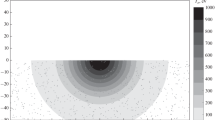Abstract
The current density on the open field lines of the Livermore spheromak (SSPX) typically exceeds the saturation current density of the bulk plasma. We assume that the mechanism that provides conditions for that is associated with the formation of a thin layer near the cathode surface, where both the plasma and the neutral density are higher than in the bulk plasma and where intense ionization occurs. The ions formed in this layer fall back onto the cathode, whereas electrons contribute to the high current density in the bulk plasma. The particle balance in the ionizing layer is determined by the recycling coefficient, which, in turn, depends on the cathode temperature and the sheath voltage. As it turns out, these dependences give rise to an instability that leads to the current filamentation and the formation of hot spots on the cathode surface. The instability can be characterized in a phenomenological manner without going into the details of the structure of the ionizing layer, whose effect on the instability shows up in the form of a couple of numerical coefficients of the order of one. We predict the characteristic size and the shape of the filaments (and the hot spots), which are in a general agreement with discoloration patterns on the surface of the cathode in the SSPX. If the magnetic field is tilted to the surface, the footpoints of the filaments move with a significant velocity, whose direction depends on the ratio of the ion gyroradius and the thickness of the ionizing layer. This instability, although primarily considered in conjunction with the SSPX experiment, may play a role in spherical tokamaks and other systems with coaxial helicity injection.
Similar content being viewed by others
References
M. V. Babykin, P. P. Gavrin, E. K. Zavoiskii, L. I. Rudakov, and V. A. Skoryupin, Zh. Éksp. Teor. Fiz. 47, 1631 (1964) [Sov. Phys. JETP 20, 1096 (1964)].
E. B. Hooper, L. D. Pearlstein, and R. H. Bulmer, Nucl. Fusion 39, 863 (1999).
D. N. Hill, R. H. Bulmer, B. I. Cohen, et al., in Proceedings of the 18th IAEA Conference on Fusion Energy, Sorrento, 2000, paper ICP/09.
H. S. McLean, S. Woodruff, E. B. Hooper, et al., Phys. Rev. Lett. 88, 125004 (2002).
P. Stangeby, The Plasma Boundary of Magnetic Fusion Devices (IOP, Bristol, 2000).
M. Ali Mahdavi, J. C. DeBoo, C. L. Hsieh, et al., Phys. Rev. Lett. 47, 1602 (1981).
D. Buchenauer, J. W. Cutberson, D. N. Hill, et al., J. Nucl. Mater. 196–198, 133 (1992).
A. Loarte, J. Nucl. Mater. 290–293, 137 (1999).
A. V. Nedospasov and V. G. Petrov, Dokl. Akad. Nauk SSSR 269, 603 (1983) [Sov. Phys. Dokl. 28, 293 (1983)].
A. V. Nedospasov and I. V. Bezludny, Contrib. Plasma Phys. 38, 337 (1998).
H. Wolff, in Atomic and Plasma-Material Interaction Data for Fusion (IAEA, Vienna, 1991), Nucl. Fusion Suppl. 1, 79 (1991).
S. M. Kaye, M. G. Bell, R. E. Bell, et al., Phys. Plasmas 8, 1977 (2001).
J. Roth, E. Vietzke, and A. A. Haas, in Atomic and Plasma-Material Interaction Data for Fusion (IAEA, Vienna, 1991), Nucl. Fusion Suppl. 1, 63 (1991).
D. D. Ryutov, P. Helander, and R. H. Cohen, Plasma Phys. Controlled Fusion 43, 1399 (2001).
H. Berk, D. D. Ryutov, and Yu. A. Tsidulko, Pis'ma Zh. Éksp. Teor. Fiz. 52, 674 (1990) [JETP Lett. 52, 23 (1990)].
T. D. Rognlien, D. D. Ryutov, N. Mattor, and G. D. Porter, Phys. Plasmas 6, 1851 (1999).
F. Wising, D. A. Knoll, S. Krasheninnikov, et al., Contrib. Plasma Phys. 36, 1996 (1996).
R. Schneider, D. Reiter, H. P. Zehrfeld, et al., J. Nucl. Mater. 196–198, 810 (1992).
T. R. Jarboe, Plasma Phys. Controlled Fusion 36, 945 (1994).
Author information
Authors and Affiliations
Additional information
From Fizika Plazmy, Vol. 29, No. 7, 2003, pp. 655–669.
Original English Text Copyright © 2003 by Ryutov, Cohen, Hill.
This article was submitted by the authors in English.
Rights and permissions
About this article
Cite this article
Ryutov, D.D., Cohen, R.H. & Hill, D.N. A phenomenological model of the current filamentation instability driven by cathode processes in the Livermore spheromak. Plasma Phys. Rep. 29, 605–617 (2003). https://doi.org/10.1134/1.1592560
Received:
Issue Date:
DOI: https://doi.org/10.1134/1.1592560




